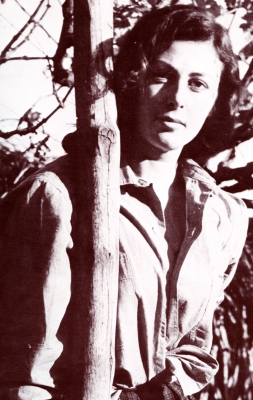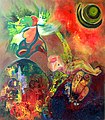Esther Eliashiv
Script error: No such module "Draft topics".
Script error: No such module "AfC topic".
| Esther Eliashiv | |
|---|---|
  Esther Eliashiv, Tel Aviv, Israel | |
| Native name | אסתר אלישיב |
| Born | Esther Slor 11 December 1930 Petah Tikva, Mandatory Palestine |
| 🏳️ Citizenship | Israeli |
| 🏫 Education | The Bezalel Academy of Art and Design in Jerusalem, Accademia di Belle Arti di Roma in Rome |
| 💼 Occupation | |
| 🌐 Website | esther |
Esther Eliashiv (Hebrew: אסתר אלישיב) (born 11 December 1930) is an Israeli painter and sculptor, who has exhibited her works on 4 continents.
Biography[edit]
Esther Eliashiv is a 4th generation Israeli born in Petah Tikva, at the time Mandate Palestine.
Esther served in the Israeli Navy in Haifa during the war of independence. Thereafter she got certified as an art teacher and during the year 1952 held a position of teacher of arts and crafts at P.I.C.A. School, Petah Tikva.
Esther studied at the Bezalel Academy of Art and Design in Jerusalem from 1953 to 1956 under the tutelage of contemporary artists Jacob Pins, Mordecai Ardon, Isidor Ascheim and Yitzhak Danziger, consequently in a continued education program at the Technion – Israel Institute of Technology. Having attained a scholarship for advanced art studies in Europe and U.S.A. she traveled in 1956 to Paris, France and later on to Rome, Italy where she studied till 1958 at the Accademia di Belle Arti di Roma. Esther got married in 1957 with Israel Eliashiv an Israeli diplomat who was serving in the Embassy of Israel in Rome at that time.
Married to an Israeli diplomat, the Israeli artist Esther Eliashiv's career has taken her to five countries on four continents where she has created art works and presented one-woman exhibitions in Israel, Canberra and Melbourne Australia (1962- 1967), Yokohama and Kobe Japan (1989), Singapore (1968-1972 and 1987-1990), Geneva and Bern, Switzerland (1977- 1982), and New York, U.S.A (1972- 1975 and 1993-1996).
In 1996 Eliashiv returned to Israel where she still lives and continues to create art, working on creating large oil paintings, combined in two or three large canvases. She lives with her husband in Tel-Aviv, has 3 children and 8 grandchildren.
Artistic career[edit]
Esther Eliashiv's creativity started at a very early age, taking art courses to feed her passion, additionally drawing and painting on paper and large terra-cota vases.
Throughout her career, Eliashiv has held numerous exhibitions in different countries; Australia, Singapore, USA, Switzerland, Japan, and Israel[1].[2]. The first solo exhibition was held at the Ben Uri Gallery in Melbourne, Australia, opened by late Prof. Zelman Cowen[1][3][4], who later became Governor-General of Australia. She held a solo exhibition in the Habima Gallery in 1983, opened by the late President Shimon Peres[5][6], prior to his second term as Prime Minister. Eliashiv was the first Israeli Woman Artist to exhibit paintings in Japan[7] and during her showings at the Sogo Galleries in Japan in 1989, she was interviewed by Japan T.V, where they had displayed some of her works.
Eliashiv held a one–woman exhibition of paintings at the United Nations, opened by the Assistant Secretary General of the U.N. and representative of the Metropolitan Museum of Art in New York[8]. During the years 1972-1975 Eliashiv acquired a strong foundation in printmaking and sculpture at the Art Students League in New York and in private workshops. She has since created numerous sculptures in bronze and terra-cota. Some of the sculptures are aimed at large bronze versions in monumental bronze and other materials.
In 1975 Eliashiv opened a studio gallery at the Hutzot Hayotzer in Jerusalem for a couple of years[9], expanding her artistic endeavors in Israel, exhibiting her works and collaborating with other artists in mixed media. In 1975 Esther Eliashiv had a joint exihbition with Māris Bišofs, award winning international caricaturist and illustrator, and in 1977 Eliashiv hosted a group exhibition with Jacob Pins with his known woodcuts[1]. Her art works can be found in private collections.
Eliashivs works are semi-abstract paintings which express the mysticism of the Scriptural stories; "In addition to powerful feelings, there is an intriguing mystic quality in her paintings expressed very skillfully through the portrayal of light"[10], "They are small treasures: the depictions float like pieces of jewelry in a fairytale-like oriental background"[11]. The subject matter of Eliashiv's work is drawn from stories in the Hebrew Scriptures, such as "Jacob's Dream" and "Adam and Eve", or "Tree of Life” a theme that recurs throughout her career[12][10][13][14][15][9][4].
-
Jacob's Ladder - Oil Painting
-
Tree of Life - Bronze Sculpture
Solo Exhibitions[edit]
- 1964 Ben Uri Galleries, Melbourne, Australia[3][4][16][17]
- 1965 Australian National University Library, Canberra, Australia[16][17]
- 1965 Gallery of the Canberra Theatre Center, Canberra, Australia[16][17]
- 1967 King David Gallery, Jerusalem, Israel[1]
- 1971 Shangri-La Gallery, Singapore[15][10]
- 1975 Gallery Internationale, Madison Avenue, New York, U.S.A[18][19][14]
- 1976 Chemerinsky Art Gallery, Tel Aviv, Israel[20]
- 1976 Museum Yad Lebanim, Petah Tikva[1]
- 1978 Gallery Maccabi, Geneva, Switzerland[1]
- 1980 Loeb Galerie, Berne, Switzerland[11]
- 1981 Galerie Arthur Didisheim, Geneva, Switzerland[1]
- 1982 The Yehoshua Gardens Art Pavilion, Tel Aviv, Israel[20]
- 1983 Habima Gallery, Tel Aviv, Israel[5][6][20]
- 1983 Bank Leumi, Jerusalem, Israel[9]
- 1986 Kefar Saba Art Center, Kefar Saba, Israel[21][20]
- 1989 Sogo Gallery, Kobe, Japan[22][13]
- 1989 Sogo Gallery, Yokohama, Japan[23]
- 1996 United Nations, New York, USA[8]
- 2002 Chagall House, Haifa, Israel[20]
Group Exhibitions[edit]
- 1976 Ogarit Gallery, Tel Aviv, Israel[1]
- 1977 Eliashiv Studio-Gallery, Hutzot Hayotzer, Jerusalem, Israel[20]
- 1977 "One Hundred Years - One Hundred Plus Artists", Yad Labanim Museum, Petach Tikva, Israel[20]
- 1994 United Nations-sponsored by UNICEF and Delta Air Lines, New York, USA[1]
- 2010 "Primaries", Bible House Museum, Tel Aviv, Israel[20]
See also[edit]
References[edit]
- ↑ 1.0 1.1 1.2 1.3 1.4 1.5 1.6 1.7 1.8 "Information Center for Israeli Art | The Israel Museum, Jerusalem". museum.imj.org.il. Retrieved 2021-11-20. Unknown parameter
|url-status=ignored (help) - ↑ "Artist files". The Guggenheim Museums and Foundation. Retrieved 2021-11-20.
- ↑ 3.0 3.1 "Featuring Ben Uri Galleries, South Yarra, Australia". The Age. 1964-12-07.
- ↑ 4.0 4.1 4.2 "Esther Eliashiv, ...colorful and vigorous expressionism". The Age. 1964-12-09.
- ↑ 5.0 5.1 "Esther Eliashiv, convincing illusions of existing form and a texture of moods". Maariv (newspaper). 1983-03-15.
- ↑ 6.0 6.1 Habima - Israels' National Theatre Journal: transcript of Opening Speech and critique by Shimon Peres, 1983-02-03
- ↑ פריאל, סיגלית (December 1990). "אשה שמציירת בעולם: המכחול נע מעצמו". הירחון לאשה ולמשפחה (in עברית). אנשים: 64.
- ↑ 8.0 8.1 Helman, Richard A. (1996-05-06). "Exhibition of Paintings at the United Nations". Diplomatic World Bulletin. New York, Pictures Pub. Co. 27: 13.
- ↑ 9.0 9.1 9.2 "אסתר אלישיב". הארץ (in עברית). 1983-09-13. p. 15.
- ↑ 10.0 10.1 10.2 Suat, Ong Choo (1971-07-17). "East is Mystic". New Nation Publishing Pte Ltd, 1971-1982. p. 26. Retrieved 2021-11-26.
- ↑ 11.0 11.1 "Esther Eliashiv, ... some pictures remind the viewer of precious fabrics". Der Bund, Bern (in Deutsch). 1980-01-16. Retrieved 2021-12-01.
- ↑ "ספריות וחדרי עיון". www.imj.org.il (in עברית). 2017-04-20. Retrieved 2021-12-01.
- ↑ 13.0 13.1 "Jerusalem, a City of Souls". Kobe Shinbun (in 日本語). 1989-06-03.
- ↑ 14.0 14.1 S, M. "Esther Eliashiv". Collectors Guide To Worldwide Art Shows. Summer Travel Issue, 1975: 38.
- ↑ 15.0 15.1 Su San, Lee (1971-07-16). "Esther Eliashiv - Art is in her, so she waits for no inspiration". The Strait Times. Retrieved 2021-11-20.
- ↑ 16.0 16.1 16.2 [Biographical cuttings on Esther Eliashiv, artist, containing one or more cuttings from newspapers or journals]. AU: National Library of Australia. Search this book on

- ↑ 17.0 17.1 17.2 "Results for 'su:Eliashiv, Esther.' [WorldCat.org]". www.worldcat.org. Retrieved 2021-11-20.
- ↑ "Esther Eliashiv - one of distinction and well worth a visit". Park East, New York. 1975-04-24.
- ↑ "Kehilath Jeshurun Bulletin Vol. XLII No. 13 | Yeshiva Libraries Digital Collections". digital.library.yu.edu. Retrieved 2021-11-20.
- ↑ 20.0 20.1 20.2 20.3 20.4 20.5 20.6 20.7 "Israel Museum Information Center for Israeli Art - Exhibitions Page". museum.imj.org.il. Retrieved 2021-11-20.
- ↑ "mm 71? [71? 11 | מעריב | 28 פברואר 1986 | אוסף העיתונות | הספרייה הלאומית". www.nli.org.il (in עברית). Retrieved 2021-11-20.
- ↑ "Esther Eliashiv, ... fantastic combination of objects and colors and they are highly appreciated in the circles of fine arts". Kobe Shinbun (in 日本語). 1989-06-01.
- ↑ "Esther Eliashiv, ... the gentle atmosphere produced by the colors is marvelous". Yokohama Shinbun (in 日本語). 1989-06-01.
External links[edit]
- Esther Eliashiv offical website
- Esther Eliashiv at the Information Center of Israeli Art, The Israel Museum, Jerusalem, Israel
This article "Esther Eliashiv" is from Wikipedia. The list of its authors can be seen in its historical and/or the page Edithistory:Esther Eliashiv. Articles copied from Draft Namespace on Wikipedia could be seen on the Draft Namespace of Wikipedia and not main one.
- CS1 עברית-language sources (he)
- CS1 日本語-language sources (ja)
- Blanked or modified
- People from Petah Tikva
- Jews in Mandatory Palestine
- Israeli Jews
- Modern painters
- Israeli contemporary artists
- 21st-century Israeli women artists
- 20th-century Israeli sculptors
- Israeli women artists
- Israeli sculptors
- Modern sculptors
- Contemporary sculptors
- Jewish sculptors
- Jewish artists
- Jewish Israeli artists
- Bezalel Academy of Arts and Design alumni
- 1930 births


